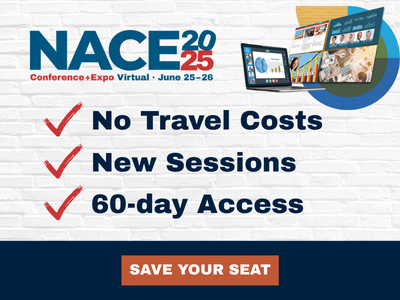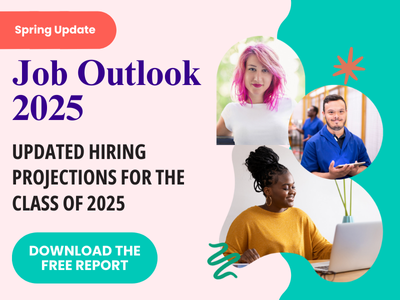Spotlight for Career Services Professionals
Last March, as a group of five colleges and universities situated along the Florida’s west coast was two weeks away from holding a joint in-person reverse career fair, career services professionals at the schools got the news that their campuses would be locked down in light of the COVID-19 pandemic. Instead of cancelling the event, organizers worked diligently to shift it to a virtual “venue.”
The group kept the date of the reverse career fair: March 26. That maintained some of the consistency with the original event, but left little time to make changes.
“When the in-person reverse career fair was going to be canceled because of the closure of our campuses in March, the career services team ‘turned on a dime’ to transition the event to a virtual platform,” explains Ben Hyland, former coordinator of internships and career readiness at USF Sarasota-Manatee.
“Team members who had experience producing virtual events volunteered their skills. Employers and students were thrilled that the event wasn't canceled. It was teamwork in action.”
Teamwork is the foundation of the Cross College Alliance (CCA), which includes New College of Florida (NCF), Ringling College of Art and Design, State College of Florida (SCF) Manatee-Sarasota, The Ringling/Florida State University, and University of South Florida (USF) Sarasota-Manatee. Alliance members share a vision “to build a network among the region's educational organizations that amplifies and expands learning opportunities for our students and the communities that surround us.”
One of the CCA’s key offerings is a reverse career fair, which differs from traditional career fairs because the tables are literally turned on the format: students sit at the tables and market themselves to recruiters. (Access the reverse career fair website for more information, including a toolkit.) CCA organizers say the reverse career fair model offers a value-added experience on both sides.
“Students know they are the center of this event, and employers know every student at the event is hungry for opportunity,” explains Bart Stucker, USF Sarasota-Manatee’s coordinator of orientation and recreation programs.
“It is a win-win, with an added win for career services professionals.”
Despite the hard work and collaborative planning that would be required to transition the reverse career fair to the virtual space, CCA wanted to hold it for the students and employers it serves because of the benefits it offers.
“With our original date for the reverse career fair quickly approaching, we had to rethink the setting of our fair on the fly or decide to cancel the event entirely,” says Madeline (Maddie) Tympanick and Ciara Suarez, assistant directors of the NCF Center for Career Engagement & Opportunity and the event coordinators for NCF.
“We were determined to make it happen and felt it was important to still provide this opportunity for our students to make connections. So we had to get creative and innovative to make this possible.”
Students built e-portfolios prior to the event, and employers who RSVP’d were given access to those e-portfolios on March 26.
Event organizers used Google Drive to create a centralized virtual space for students to present their e-portfolios housed in individual Google folders as a way to demonstrate their skills, talents, and interests to employers.
“In addition,” Tympanick and Suarez add, “using Google Drive meant it was at zero cost to us. We pitched the idea to the rest of the NCF and CCA team and received a resounding and unanimous agreement to move forward with this idea.”
The group encouraged participating students to include:
- A recording of their elevator pitch;
- A PDF copy of their resume or CV;
- A PDF copy of their business card; and
- Electronic artifacts (such as pictures/graphic designs, presentations, posters, thesis/writing samples) that showcased their abilities, experience, and knowledge.
During the in-person reverse career fair, students were going to showcase these items at their own tables and give their elevator pitches in person. Prior to the lockdown, career services practitioners offered group prep sessions and career coaches met with their cohort of students one-on-one for individual coaching.
After the lockdown, each career coach made it a point to connect with their students to ensure that the students felt prepared and supported during the transition from an in-person to virtual format.
Since NCF was going to host the in-person fair on its campus, it created the private Google Drive folder that housed individual student e-portfolios within their own folder. All participating students from each CCA institution were included in this Google Drive folder.
The career services representative(s) from each CCA institution, gathered the electronic items to put in their students’ e-portfolio. Only career services staff had access to the Google Drive folder until the link was sent out to employers.
“This way, we ensured that the folders remained private and career services staff could manage the Google Drive folder,” note Tympanick and Suarez.
“Students were organized alphabetically by last name and we created a map—also organized alphabetically by last name to mirror the Google Drive folder—to assist employers with navigating this new virtual setting.”
The map included information about each student, such as careers/industries of interest and types of opportunities the students were seeking (part-time or full-time jobs, internships, summer opportunities, and more), which allowed employers to target specific students.
“We avoided including majors or areas of concentrations to prevent employers from pigeonholing any student based on their area of study,” Tympanick and Suarez explain.
On the day of the fair, the CCA team emailed the Google Drive link to all employers so they could access the student folders.
“We encouraged employers to reach out to students directly and most students received emails, LinkedIn messages, or phone calls following this event,” says Dwayne Peterson, director of the NCF Center for Career Engagement & Opportunity.
Adds Hyland: “Each institution recruited and trained their students separately, but we shared lesson plan ideas throughout the process. Our survey data show the training program was consistently praised by both employers and students—even in a virtual space.”
Group members knew the event’s success would come from connecting as many of their students as possible with as many employers as possible to start landing interviews. But there were several other outcomes that underscored the reverse career fair’s effectiveness, including:
- No money was spent to execute this online event.
- Thirty-two students from across all three institutions built e-portfolios that were shared via Google Drive and included resumes, elevator pitch videos, research artifacts, and more. Originally, 41 students planned to participate, so COVID-19 did impact these numbers. However, the number from the virtual reverse career fair is up from 26 students at the original reverse career fair in 2018.
- Seventy-six employer representatives accessed student e-portfolios. This number is up from 62 employer representatives at the original reverse career fair in 2018.
- More than half of all student participants were offered at least one interview, and several landed jobs and internships.
- All students “agreed” or “strongly agreed” that the staff-led training program leading up to the event was a key differentiator in their success.
“We learned that perseverance pays off,” Tympanick and Suarez say.
“We were determined to hold this event to connect our students to opportunities, even if it meant changing almost every aspect of the fair. This determination, combined with the dedication and flexibility of our students, made this event a success. We had to overcome some challenges with communication and student engagement, as students were being impacted by issues like housing insecurity, financial instability, and limited access to resources and support once they left campus.
“In spite of these challenges, we were able to retain 32 of the 41 students—78 percent of students. There was a silver lining: When the event went virtual, we increased the number of employers from 30 to 76, likely due to the fact that other recruiting programs were being cancelled nationally.”
The CCA team—which is planning to hold another virtual reverse career fair this academic year—offers several recommendations to their career services colleagues for holding events in an uncertain environment, including:
- Getting creative and staying flexible—In these unprecedented times, practitioners are being forced to think outside the box to find new and innovative ways to connect students to opportunities. Explore every way that you can do this safely and effectively.
- Preparing for the unexpected—Block off buffer time to allow yourself to create solutions in the moment, and adapt those to your immediate needs.
- Collaborating when and where you can—Seek out partnerships that can be beneficial to your work. Collaborating with other regional institutions that are a part of the CCA gave all of the institutions an advantage because they were able to diversify the employers that were attracted to this recruitment opportunity. Each institution offers different types of students, programs, and strengths, which helped the event stand out. It was representing a region of talent, which is unique, but also benefits every student because they are able to engage with the diverse employers that were attracted to the recruiting event. Collaborating with the CCA also allowed the institutions to access and use additional resources.
- Thinking strategically about how to leverage technology in new ways—For example, organizers wanted to include student voices through uploading an elevator pitch. Originally, students spent time preparing an elevator pitch that would be essential for employers to hear at an in-person fair. To simulate an in-person fair, the group used InterviewStream as a way to give each student an assignment to record an elevator pitch through the system that could be uploaded into their e-portfolio.
- Communicating—Organizers had to stay on top of providing timely and accurate information to their CCA colleagues, employers, and students.
While it required substantial planning and work, shifting the reverse career fair to virtual paid off.
“CCA colleagues effectively leveraged and expanded their institutions’ employer networks, which resulted in the overall increase in the number and satisfaction of participating employers, and efficiently created a valuable new program/experience for more students,” Stucker explains.
“Students were able to significantly increase their employer networks and overall satisfaction with event outcomes as a result of the opportunity to interact and demonstrate their interests and accomplishments to many more employers.”







